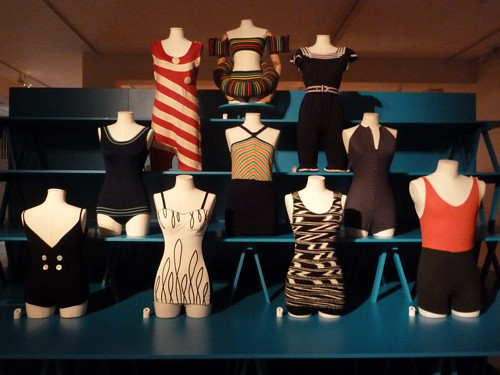
Lannoo Publishers recently released a new book on the history of knitwear titled, Unravel: Knitwear in Fashion by Emmanuelle Dirix. Dirix teaches costume history at the fashion department of the Antwerp Academy and the book was published to coincide with an exhibition at the Fashion Museum in Antwerp (on view through August 14). Articles on the exhibition have already come out from A Shaded View and Dazed Digital. For more on the exhibit, check out this interview with MoMu’s curator Karen Van Godtsenhoven.
The catalog, however, is a hidden gem that could easily slip under the radar of many a fashion historian. It is printed in both English and Dutch, and includes a dozen essays covering various aspects of knitwear history as well as interviews with current knitwear designers and artists (including Sandra Backlund) . I am particular fond of the essays “Drop One, Pick Up Two, Drop One” by Emmanuelle Dirix , “Knitting for Victory” by Jane Tynan and “Twinset and Match” by Alistair O’Neill.

Dirix’s essay traces the history of knitwear from home knitting and ‘hobby culture’ in the arts and crafts movement through Chanel and Schiaparelli and Patou’s use of knitwear for sportswear and into the use of surrealism and trompe le’oeil sweaters of the 1930s. Her research continues through WWII, post-war era of refinement and into the youth rebellion designers of Mary Quant, Rudi Gernreich and Biba (among others). Her essay leaves off suggesting that the 1980s and 1990s held the “most shocking and subversive knitwear chapter in history” due to the ad campaigns by Italian knitwear label Benetton and its use of racial politics, the Aids epidemic and child labor to shock viewers.
 Jane Tynan‘s essay “Kniting for Victory: Military Chic in Fashion Knitwear” tackles one of my favorite topics – knitting ‘comforts’ during wartime. Of particular interest is a booklet discussed in her essay titled “Women & War: How to Knit and Crochet Articles necessary to the Health and Comfort of our Soldiers and Sailors” (1914-1918). “In Twinset and Match: The Culture of the Twinset” by Alistair O’Neill, addresses the development of the iconic image of the woman in a twinset – including the work of Pringle of Scotland, hollywood starlets and the pre-war and post-war context of the sweatergirl. I should also mention the essays by Lydia Kamitsis (“Knitwear in French Fashion: From Gabrielle Chanel to Sonia Rykiel” and Joanne Turney: (“Dressing Like Grandad: Geek Chic and the Significance of the Cardigan in Contemporary Menswear.”)
Jane Tynan‘s essay “Kniting for Victory: Military Chic in Fashion Knitwear” tackles one of my favorite topics – knitting ‘comforts’ during wartime. Of particular interest is a booklet discussed in her essay titled “Women & War: How to Knit and Crochet Articles necessary to the Health and Comfort of our Soldiers and Sailors” (1914-1918). “In Twinset and Match: The Culture of the Twinset” by Alistair O’Neill, addresses the development of the iconic image of the woman in a twinset – including the work of Pringle of Scotland, hollywood starlets and the pre-war and post-war context of the sweatergirl. I should also mention the essays by Lydia Kamitsis (“Knitwear in French Fashion: From Gabrielle Chanel to Sonia Rykiel” and Joanne Turney: (“Dressing Like Grandad: Geek Chic and the Significance of the Cardigan in Contemporary Menswear.”)
This book is a gem, and features excellent writing by a number of authorities from an amazing array of viewpoints. If like me, you can’t make it to exhibition at the Fashion Museum in Antwerp before August 14, the catalog makes up for it in spades:










2 Comments
Also check out my interview with Karen on Fashion Projects! http://www.fashionprojects.org/?p=2372
Thanks so much Sarah! Glad to see you’re a reader 🙂 Thanks too for the link to your interview.